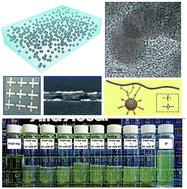Interface structure, precursor rheology and dielectric properties of BaTiO3/PVDF–hfp nanocomposite films prepared from colloidal perovskite nanoparticles
Abstract
Nanocomposite materials with uniform microstructure and high permittivity have attracted extensive interest in modern electronics. The compatibility between the filler phase and the polymer matrix is crucial in preparing high-performance composites. As an alternative to conventional surface modification treatment methodologies, hydroxylated colloidal BaTiO3 (BT) nanoparticles synthesized via a green and scalable process were directly used to fabricate high-permittivity nanocomposites. Interfacial interaction analyses between the BT nanoparticles and polymer matrix reveals that due to strong hydrogen bonding at the interface, transparent composite sols with excellent flow behavior can be observed. The sols are ideal formulations for the preparation of BT/PVDF–hfp 0–3 nanocomposite films. Owing to the unique interface structure, the composite films show a dense and uniform microstructure and superior dielectric properties. Parallel plate capacitor devices and the co-development of a sandwich architecture leads to the ability to prepare dielectric films with favorable performance characteristics. This method provides a novel and greatly simplified strategy for the fabrication of high-permittivity dielectric nanocomposites.



 Please wait while we load your content...
Please wait while we load your content...